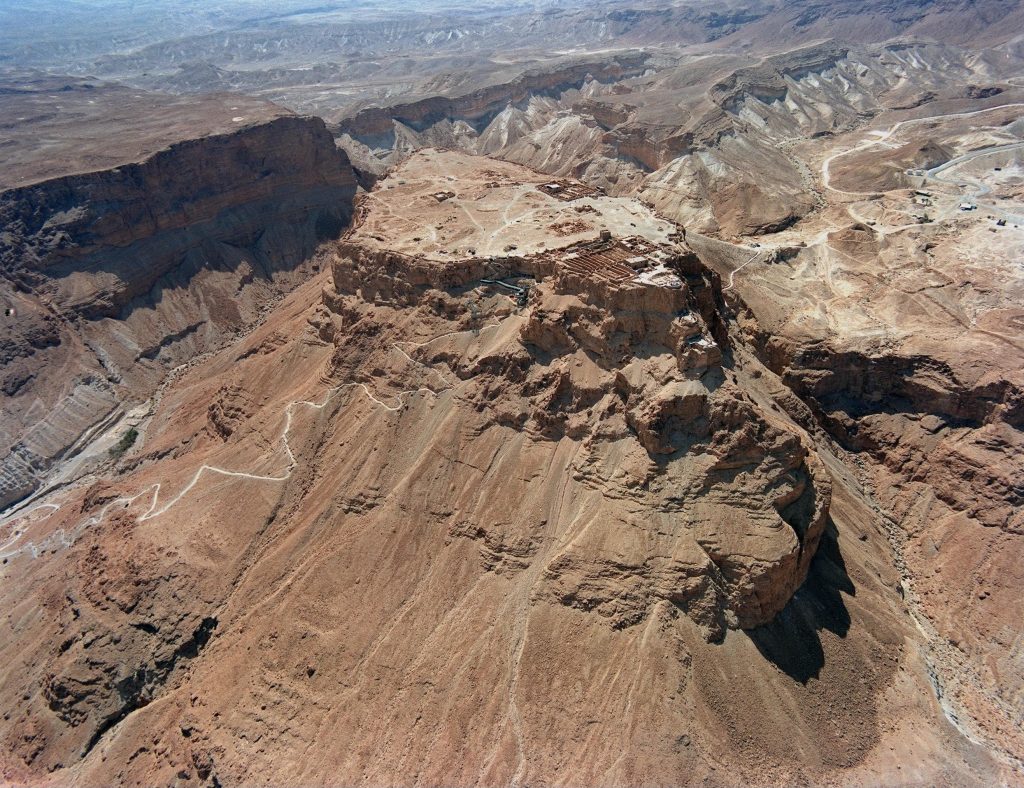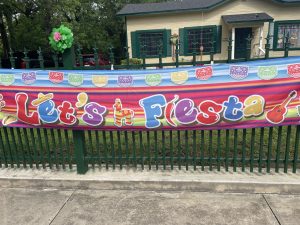Masada was an impressive fortress built upon a plateau to protect Jewish Zealots and refugees from the Romans. The Jews wisely chose this location because of its natural defenses against invaders. They imagined it would be impossible for anyone to besiege the city; the treacherous terrain and great outer wall surrounding Masada surely would protect it. Unfortunately, the Jews underestimated the Roman army.

Masada appeared to be the perfect fortress. Its four vertical sides made it nearly impossible to invade. The largest wall on the eastern side is one hundred forty meters above the desert floor, roughly half the size of the Eiffel Tower. From the east, there is a dangerous zig-zagging trail called the serpent’s path. The western side wall is eighty meters above the desert floor, as tall as the Statue of Liberty. The inhabitants took the extra precaution and built two walls on the perimeter of the plateau about 1400 meters long and six meters tall. The outer wall was 1.4 meters thick and the inner was 1 meter thick. Between the inner and outer wall, there was an empty space. During an invasion they planned to fill the gap with stone, wood, and dirt to strengthen the wall; until then it was used for storage. There were also twenty-meter-tall towers strategically spaced out throughout Masada for defensive reasons.1
The defenders were aware that if one were to attack, the first action the enemy would take would be to stop the water supply. Anticipating that possibility, the defenders built twelve cisterns to hold the water inside the fortress. Along the western slopes they had enough water stored to fill sixteen Olympic pools. It was very forward thinking of the Jews to do this. They also had many food storehouses toward the north. They kept grain, oils, corn, wine, dates, along with other foods. Thanks to the dry climate, storing the food was not a problem. In case they were to run low, the flat land would be ideal to grow additional food. Remains of the wall, tower, cisterns, food storage buildings, and other structures are still visible today.1

Unfortunately, these precautions were no match for the Roman army. In 73 C.E., Flavius Silva marched the Roman army and other troops totaling about 10,000 soldiers south to conquer Masada. Waiting on top of Masada were the 1,000 men (Jewish refugees and Zealots) willing to defend their safe haven. The Romans were aware it would take a significant amount of time to destroy Masada, so they set up camp and had Jewish war prisoners bring a constant supply of food and water. They first stopped up the aqueducts and diverted them for their own use. Next, they constructed a wall around Masada to prevent the inhabitants from escaping, and to cut them off from the outside world, a classic Roman war operation. The wall was three meters high and 3.2 kilometers long, and enforced by eight camps with many other guards posted. This impressive mechanism was built in a matter of days and can still be seen today.1

The Romans knew this would not be a quick victory; they would have to overthrow Masada by force. They came to the conclusion that the only way to reach the top of Masada was by making the steep side into a gradual incline. To do this, they took advantage of a natural spur called the white rock on the western side. It was nearly two hundred meters from the top of Masada to the edge of the natural gulf. The ramp to the top was built at a twenty degree incline. It took months to build the massive ramp. Every day, the inhabitants of Masada would wake up to see the enemy growing closer and closer, with no way for them to escape. As the Romans got close to the top, they became more vulnerable to the defenders. The Jews at the top could now shoot arrows and defend themselves against the Romans. As a result, the Romans had the Jewish war prisoners shield them so that they could shoot back. Within two months, the great ramp was complete. It was two hundred twenty meters long, and archaeologists assume it weighed as much as one and a half empire state buildings.4
The Romans attacked Masada with their siege towers. They rolled the massive towers up the man-made ramp to overthrow Masada. The inhabitants tried to fight back, shooting arrows at the towers and trying to destroy it with fire.4 The day before the final attack, the Romans carefully planned how they would conquer Masada. Early that morning, they charged up the ramp, and over the walls. To their surprise, they were not met with a fight. Instead, they encountered thousands of dead bodies. The few remaining women and children explained to them what had happened. The Jews knew they did not stand a chance against the Roman army of 10,000. They decided it would be better to die than to be conquered. Since Judaism does not allow suicide, they came to the conclusion they would have to kill each other. The men first killed the children and women; then they cast lots to decide who would be killed first, and who would have to be the last to commit suicide. It is ironic how they ignored the sixth commandment not to murder, but decided to alter its meaning to mean not to murder yourself. Despite the confusion, they ultimately chose death over slavery.6
- Encyclopedia Judea, 2007, s.v. “Masada,” by Michael Berenbaum. ↵
- Encyclopedia Judea, 2007, s.v. “Masada,” by Michael Berenbaum. ↵
- Encyclopedia Judea, 2007, s.v. “Masada,” by Michael Berenbaum. ↵
- The Greenhaven Encyclopedia of the Ancient World, 2002, s.v. “Siege of Masada,” by Don Nardo. ↵
- The Greenhaven Encyclopedia of the Ancient World, 2002, s.v. “Siege of Masada,” by Don Nardo. ↵
- Encyclopedia of Death & Human Experiences, 2009, s.v. “Mass Suicide,” by Clifton D. Bryant. ↵



86 comments
Cristina Cabello
I have never heard of the Mass Suicide of Masada. But this is truly a terrible event. Every single life is precious. I find it really interesting how people can be so creative and smart. By making a fortress out of the natural white rock is outstanding. But not knowing if it would work or not they had to try something. I guess it is good to take risks in life.
Edgar Ramon
Firstly, let me say that this was a horrible event. However, It is honestly amazing to see how crafty people could be when it came to survival, and planning. I am talking about the water supply that the Masadans had, how well the location for their town was chosen, and how the romans took their time to reach them. Upon starting to read the article, the first thing that came to mind was ‘cut the food and water supply’, then read into them having water stores, and though, well idk. The romans actually createad a steady incline, and its not just here, the way they adapted to defeat the Carthaginians was also amazing. Well done.
Auroara-Juhl Nikkels
I had never heard of Masada or the mass suicide that happened there before reading your article. It is very impressive to learn how these people were able to create a fortress out of the natural rock that was in the area. I wish I could say I was surprised that the Romans and Jewish fought a battle, but I am not. I am, however, surprised to learn that the Jewish committed mass suicide. But if i were being honest, I would also kill myself rather than enter into slavery. I was also surprised because so many mass suicides that we read about are from cults. I expected this one to be when I started it.
Carlos Vazquez
This was such and interesting article, I had never heard of Masada fortress and the mass suicide that followed the invasion of the Romans. The Romans were able to conquer the majority of Europe and the Mediterranean, so it was only a matter of time until they reached the Jews in Masada. This article was very well written and Informative. I really enjoyed reading this article!
Tyler Thompson
This article was very well written and very interesting. The Jewish people were very strategical and must have been amazing architects to develop such a structure that many people could not conquer. The story was very interesting at the end when the Romans were preparing to conquer to only see that they had all killed themselves. I wonder how long the civilization would’ve lasted had they not been under attack.
Caroline Bush
Interesting article! I had never heard about the Masada fortress until reading this article. After reading this however I have to say that it is impressive how they were able to create a fortress out of the natural white rock. I think that its horrible how the Romans and the Jews slaughtered each other during this battle. The outcome of this battle really surprised me but I guess when given the choice between slavery or death you would choose the latter. Overall I enjoyed the amount of detail in this article and found it very interesting.
Natalia Flores
How awful that they slaughtered each other! Then again, it was better than being a slave to the very people you tried to escape from. It’s impressive how both sides thought of creative ways to both defend and attack each other. The impressive feat of creating a city on the top of that plateau and the use of the natural White Rock slope as a way to create a ramp is genius. In the end, it came down to whether to live as a slave or die.
Timothy ODekirk
This article is extremely interesting to me, given the fact of the circumstances between the Jews and the Romans. I was unfamiliar with this battle of Masada between the Romans and the Jews. The Romans, being as powerful as they were, destroyer the Jews and Masada. I also find it interesting how the Jews did not want to surrender, so instead, they committed a mass suicide. This is because they knew they were going to be enslaved, so they thought it was best to just end everything on that defeat of the Battle of Masada.
Kimberly Simmons
I had never heard of this fortress until coming upon this article! It’s extremely interesting how the walls were so intricately built and packed for protection against invaders – they thought of almost everything. It’s unfortunate that the Roman invaders overpowered them so easily, even more so that the Jews elected to die rather than to be enslaved. A sad story, but very informative.
Robert Rodriguez
Wow! The descriptions of this article gave me a good picture of the layout and how the events went down. I found it kind of sad that the Jews had to resort to a land like that to feel safe, even at that they weren’t safe. I was complete shocked to find out that they ultimately killed themselves not by the Romans nor suicide but murder and with a lottery system to choose who dies first just to keep in compliance with the commandments.